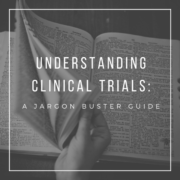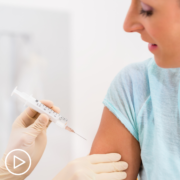Understanding Clinical Trials: A Jargon Buster Guide
When it comes to cancer treatment you or a loved one may be considering participating in a clinical trial as a treatment option. Clinical trials are designed to evaluate the safety and effectiveness of a treatment. They may involve researchers administering drugs, taking blood or tissue samples, or checking the progress of patients as they take a treatment according to a study’s protocol.
Learning about clinical trials can be a steep learning curve – not least because the process comes with a lot of new terms, acronyms and jargon. To help you, I’ve put together this list of the most common terms you will find when you are researching clinical trial information. This is not an exhaustive list but it is a helpful starting point. At the end of this article you will see links to find more information.
Adverse Effects (AE)
Also called Adverse Events, or Adverse Drug Reaction, AEs are any harmful event experienced by a person while they are having a drug or any other treatment or intervention. In clinical trials, researchers must always report adverse events, regardless of whether or not the event is suspected to be related to or caused by the drug, treatment or intervention.
Arm
Subsection of people within a study who have a particular intervention.
Bias
Bias is an error that distorts the objectivity of a study. It can arise if a researcher doesn’t adhere to rigorous standards in designing the study, selecting the subjects, administering the treatments, analysing the data, or reporting and interpreting the study results. It can also result from circumstances beyond a researcher’s control, as when there is an uneven distribution of some characteristic between groups as a result of randomization.
Blinding
Blinding is a method of controlling for bias in a study by ensuring that those involved are unable to tell if they are in an intervention or control group so they cannot influence the results. In a single-blind study, patients do not know whether they are receiving the active drug or a placebo. In a double-blind study, neither the patients nor the persons administering the treatments know which patients are receiving the active drug. In a triple-blind study, the patients, clinicians/researchers and the persons evaluating the results do not know which treatment patients had. Whenever blinding is used, there will always be a method in which the treatment can be unblinded in the event that information is required for safety.
Comparator
When a treatment for a specific medical condition already exists, it would be unethical to do a randomized controlled trial that would require some participants to be given an ineffective substitute. In this case, new treatments are tested against the best existing treatment, (i.e. a comparator). The comparator can also be no intervention (for example, best supportive care).
Completed
A trial is considered completed when trial participants are no longer being examined or treated (i.e. no longer in follow-up); the database has been ‘locked’ and records have been archived.
Control
A group of people in a study who do not have the intervention or test being studied. Instead, they may have the standard intervention (sometimes called ‘usual care’) or a dummy intervention (placebo). The results for the control group are compared with those for a group having the intervention being tested. The aim is to check for any differences. The people in the control group should be as similar as possible to those in the intervention group, to make it as easy as possible to detect any effects due to the intervention.
Efficacy
How beneficial a treatment is under ideal conditions (for example, in a laboratory), compared with doing nothing or opting for another type of care. A drug passes efficacy trials if it is effective at the dose tested and against the illness for which it is prescribed.
Eligibility Criteria/ Inclusion and Exclusion Criteria
Eligibility criteria ensures patients enrolling in a clinical trial share similar characteristics (e.g. gender, age, medications, disease type and status) so that the results of the study are more likely due to the treatment received rather than other factors.
Follow-up
Observation over a period of time of participants enrolled in a trial to observe changes in health status.
Informed Consent
A process (by means of a written informed consent form) by which a participant voluntarily agrees to take part in a trial, having been informed of the possible benefits, risks and side effects associated with participating in the study.
Intervention
The treatment (e.g., a drug, surgical procedure, or diagnostic test) being researched. The intervention group consists of the study participants that have been randomly assigned to receive the treatment.
Investigator
A person responsible for the conduct of the clinical trial at a trial site. If a trial is conducted by a team of individuals at a trial site, the investigator is the responsible leader of the team and may be called the principal investigator (PI).
Multicentre Trial
A clinical trial conducted according to a single protocol but at more than one site, and therefore, carried out by more than one investigator.
Number needed to treat (NNT)
The average number of patients who need to receive the treatment or other intervention for one of them to get the positive outcome in the time specified.
Outcome Measures
The impact that a test, treatment, or other intervention has on a person, group or population.
Phase I, II, III and IV Studies
Once the safety of a new drug has been demonstrated in tests on animals, it goes through a multi-phase testing process to determine its safety and efficacy in treating human patients. If a drug shows success in one phase, the evaluation moves to the next phase
- Phase 1 tests a drug on a very small number of healthy volunteers to establish overall safety, identify side effects, and determine the dose levels that are safe and tolerable for humans.
- Phase II trials test a drug on a small number of people who have the condition the drug is designed to treat. These trials are done to establish what dose range is most effective, and to observe any safety concerns that might arise.
- Phase III trials test a drug on a large number of people who have the condition the drug is designed to treat. Successful completion of Phase III is the point where the drug is considered ready to be marketed.
- Phase IV trials can investigate uses of the drug for other conditions, on a broader patient base or for longer term use.
Placebo
A fake (or dummy) treatment given to patients in the control group of a clinical trial. Placebos are indistinguishable from the actual treatment and used so that the subjects in the control group are unable to tell who is receiving the active drug or treatment. Using placebos prevents bias in judging the effects of the medical intervention being tested.
Population
A group of people with a common link, such as the same medical condition or living in the same area or sharing the same characteristics. The population for a clinical trial is all the people the test or treatment is designed to help.
Protocol
A plan or set of steps that defines how something will be done. Before carrying out a research study, for example, the research protocol sets out what question is to be answered and how information will be collected and analysed.
Randomized Controlled Trial (RCT)
A study in which a number of similar people are randomly assigned to 2 (or more) groups to test a specific drug, treatment or other intervention. One group has the intervention being tested; the other (the comparison or control group) has an alternative intervention, a placebo, or no intervention at all. Participants are assigned to different groups without taking any similarities or differences between them into account. For example, it could involve using a computer-generated random sequence. RCTs are considered the most unbiased way of assessing the outcome of an intervention because each individual has the same chance of having the intervention.
Reliability
The ability to get the same or similar result each time a study is repeated with a different population or group.
Sample
People in a study recruited from part of the study’s target population. If they are recruited in an unbiased way, the results from the sample can be generalised to the target population as a whole.
Subjects
In clinical trials, the people selected to take part are called subjects. The term applies to both those participants receiving the treatment being investigated and to those receiving a placebo or alternate treatment.
Trial Site
The location where trial-related activities are conducted.
References
The Canadian Institutes of Health Research (CIHR)
Further Resources
American Society of Clinical Oncology’s Cancer.Net trials site
ClinicalTrials.gov database of privately and publicly funded clinical studies
CenterWatch Clinical Trials Listing

A Stanford Medicine X e-Patient scholar, Marie Ennis O’Connor is an internationally recognized keynote speaker, writer, and consultant on global trends in patient engagement, digital health and participatory medicine. Marie’s work is informed by her passion for embedding the patient voice at the heart of healthcare values. She writes about the experience of transitioning from breast cancer patient to advocate on her award-winning blog Journeying Beyond Breast Cancer.










